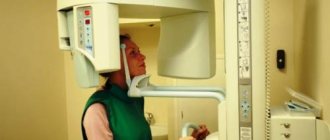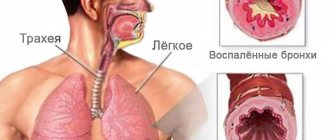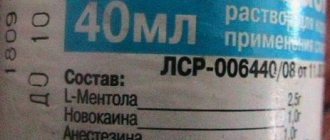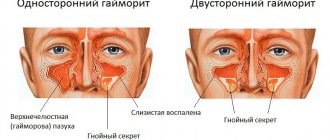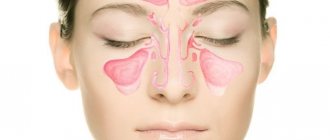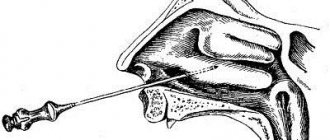Causes of this disease
Sinusitis is a diagnosis of a disease that cannot be immediately determined. To recognize it, you need to understand its origin. It is necessary to learn to differentiate certain factors that provoke the development of the disease. There are many of them, they are all different. If the causes of the disease are correctly identified, the treatment will become more effective.
Known causes may be:
- Allergy;
- Trauma or structural features in the sinus;
- Weakened immunity;
- Diseases of the teeth, oral cavity;
- Complication from sinusitis or rhinitis;
- Acute and chronic infections;
- Untreated acute respiratory infections, acute respiratory viral infections;
- Congenital predisposition, heredity.
Diagnosing sinusitis in adults is much easier than in a child. In children it occurs in a milder form and can be confused with a cold. An adult has more purulent discharge and can better explain what is happening to him.
What other signs indicate that it is sinusitis?
If sinusitis begins acutely, then recognizing it is quite simple. But often it acts much more “cunningly” and develops little by little, masquerading as a common runny nose or banal fatigue. Therefore, during the period of general sneezing and flu, you need to pay attention to the following signs that indicate that you are faced with sinusitis.
- A persistent runny nose does not go away for more than a week. Due to severe swelling of the mucous membrane, the nose is constantly stuffy, respiratory function is reduced, there are changes in the voice (it becomes nasal, loses sonority).
- There are no dental diseases, but you clearly feel that your upper teeth hurt.
- You constantly feel painful pressure on your entire face, or the pain may be localized only between the eyes.
If you have any of these symptoms, then you should immediately go to the doctor. To clarify the diagnosis, the necessary tests and studies will be prescribed. Sinusitis is clearly visible on x-rays.
It is necessary to treat sinusitis, since it easily becomes chronic, and this is fraught not only with constant fatigue, the inability to sleep normally and taste food, but also with other troubles. In particular, the constantly swollen and inflamed mucous membrane can begin to degenerate, which will lead to the growth of nasal polyps. Then nasal breathing will become completely impossible, and it can only be restored through surgery.
The doctor will tell you what is the best way to treat sinusitis. Mild forms respond well to conservative treatment, but in more serious cases surgery will have to be performed. (You can read about physiotherapy for sinusitis here).
So, dear friends, I hope that now you can easily, if necessary, suspect something is wrong in time and not waste precious time. And I sincerely wish you never to encounter the symptoms of sinusitis in your life.
How does the disease manifest itself?
Symptoms that will indicate all the signs that a person has sinusitis should immediately lead him to the doctor to confirm the diagnosis. These are difficulty breathing, purulent discharge from the nose, pain in the forehead, pain in the eyes, cough, toothache, insomnia, fever, red eyes, unpleasant odor, hoarseness of voice.
Before you understand that you have sinusitis, you need to find out what types of this disease there are and how they manifest themselves. How to determine the type of sinusitis?
It comes in several types. Allergic, acute, chronic, caused by fungi.
- Allergy is determined by swelling of the mucous membrane, face, eyelids. Copious liquid discharge does not stop, there may be sneezing and fever.
- Acute is characterized by acute pain in the eyes, forehead, nose, and teeth. Facial swelling, congestion and fever also appear.
- Chronic is similar to acute, only it lasts more than a month, nothing helps, it is less painful, without increasing body temperature.
- Fungal can be distinguished by purulent discharge with an odor or blood, severe pain in the head, forehead, nose.
See also
Treatment of sinusitis with drugs based on Cyclamen
Read
If you start the disease, the consequences will be very dire.
General symptoms
Classic signs of sinusitis that occur at any age are:
- Pain in the nose, sinus and upper jaw;
- Heaviness and pressure of the maxillary sinus;
- Increased pain when tilting the head down;
- Nasal congestion on one or both sides;
- Discharge of mucous exudate;
- Disturbance and difficulty in nasal breathing;
- Deterioration of smell perception;
- Unpleasant odor from the nasal cavity;
- Swelling in the maxillary sinus area;
- Cough and voice change;
- Headache;
- Increased body temperature;
- Sleep disturbance;
- Weakness and malaise.
All symptoms of the disease can be divided into general and local. Common ones include weakness, fever, decreased immunity, and so on. They indicate the presence of an acute inflammatory process in the body, the spread of infection and the body’s reaction at the systemic level. Local symptoms - pain in the sinus, congestion, nasal discharge indicate inflammation of the mucous membrane of the maxillary sinus and localization of the process. With minor inflammation and a sufficiently strong immune system, general signs of the disease may not occur.
Useful: Diet for allergies
How to diagnose sinusitis
If you do not know how to identify sinusitis at first, you need to contact an otolaryngologist. The hospital conducts examinations and diagnoses various diseases.
If a person thinks: “I have sinusitis,” then he already recognizes its signs.
The doctor asks the patient what symptoms have been present in recent days, examines the nasal cavity, and asks about the nature of the pain and discharge. Examination of the inner surface of the nose may show swelling, irritation of the mucous membrane, and pus. He asks if he had sinusitis before, if anyone in the family was sick.
Before you find out for sure about the presence of this disease, you need to take an X-ray or tomography of the nose. This test is safe not only for adults, but also for children. Moreover, it is very effective in terms of diagnosis. Although sinusitis in a 3-year-old child is extremely difficult to diagnose. In the photographs, the appearance of the sinuses is the same as in acute rhinitis. Additional research is required here.
The doctor must determine the nature and type of the disease: chronic, allergic or acute. Based on the differential diagnosis of sinusitis, a final diagnosis is made and treatment is prescribed.
First signs
By the first signs you can distinguish this disease from ordinary rhinitis. Usually the most common symptoms are fever, pain in and inside the nasal passages, headaches especially in the forehead area, weakness, and aches. If there is no temperature, but there are all the signs on the face, then it may be chronic sinusitis.
A person has difficulty breathing, his mouth is dry, he cannot sleep normally, and his appetite decreases. The entire area of the face is inflamed, as if swollen. There is severe pain when tilting the head.
Sometimes the pain spreads to the teeth, jaw, cheeks. There is a feeling of cold and chills. Sneezing and coughing appear. The nose is stuffy; if you press on the bridge of the nose, severe pain occurs.
See also
Symptoms and treatment of viral sinusitis and sinusitis
Read
The discharge is purulent in color and can often be mixed with blood. They are liquid. A person tries to hide from the bright light, he wants to lie down, it is difficult to work, his eyes turn red.
How to determine sinusitis?
The cause of sinusitis is usually an infection. A deviated nasal septum can also provoke the development of the disease. If you do not pay attention to the obvious signs of sinusitis in time, you can subsequently get a serious complication. But there is a way to avoid such problems. To do this, it is enough to have an idea of how to recognize sinusitis
. First of all, the presence of fever and loss of smell should already alert you. Sinusitis is often accompanied by severe headaches, which are mainly localized in the frontal region. They are especially acute when moving or tilting the head. If you notice some of the symptoms presented, then things are bad:
- chills;
- elevated temperature;
- nasal congestion;
- loss of smell;
- excruciating pain in the forehead and at the base of the nose;
- swelling of the eyelids
Normal hypothermia can provoke the development of this disease. Sinusitis often occurs against the background of colds. As soon as the infection settles in the maxillary sinuses, the inflammatory process leads to the fact that pus begins to be released from the nose. The patient feels a loss of strength, apathy and increased fatigue appear.
Treatment of children
When sinusitis is diagnosed, the necessary treatment is prescribed. In adults and in children 2, 3, 4 years old, this treatment is different. Before 1 year of age, this disease is quite rare.
The first step is to rinse the nose with various antiseptic sprays and drops. Vasoconstrictor medications may be prescribed.
Also, if the form is acute, antibiotics and antiviral drugs are prescribed. They can be in the form of tablets or suspension. In extreme cases, injections are given.
When sinusitis is severe and acute, punctures are made in order to remove all the pus, rinse the nasal cavity, and treat it. Punctures are made in the area in front of the maxillary sinuses. The procedure is performed under anesthesia.
Surgical intervention is prescribed in advanced forms.
Some doctors recommend using traditional methods to relieve symptoms. This includes instillation of beet juice, aloe, and inhalation with herbs. Massages and breathing exercises are also useful. Walk more in parks, forests, breathe clean fresh air.
How to distinguish sinusitis from a runny nose
The onset of the disease is very similar to a common cold, acute respiratory viral infection or acute respiratory infection, since its symptoms are typical of respiratory tract infections. But with a more attentive attitude to your health, some features that are uncharacteristic of a common runny nose become noticeable.
Pain with sinusitis is felt in the sinuses, forehead and bridge of the nose
So how can you tell the difference between sinusitis and a runny nose? The main sign that helps recognize sinus inflammation is the location of pain. Discomfort is felt in the forehead and under-eye area, bridge of the nose. The unpleasant feeling intensifies when pressing on the projection site of the sinuses on the skin, while sneezing and blowing your nose. Later, the pain moves to the upper jaw, creating the appearance of dental pathology.
When bending forward, and later in a vertical position, a feeling of fullness appears in the bridge of the nose and nasal cavities.
The patient's general condition also worsens. On the 4th–5th day of rhinitis, when the ailment should subside, a person is faced with an unexpected deterioration in well-being. Signs of intoxication of the body are formed:
The first signs of sinusitis
- the temperature rises to 38.0–39.0° C;
- weakness, sweating, lethargy appears, especially in the evening;
- there is a severe headache;
- appetite worsens.
Sinusitis, which occurs without a runny nose, has the same symptoms of the onset of the disease. Patients often complain of swelling of the face. Swelling is especially noticeable with unilateral lesions.
Another specific sign of sinusitis is the color of the discharge. With ordinary rhinitis, the snot is initially liquid and transparent, gradually it thickens and after 6-7 days it disappears completely. When the sinuses are affected, a different picture is observed. The discharge acquires an unpleasant odor and hue, and an admixture of blood appears. The color of snot during sinusitis depends on the type of illness.
With unilateral sinusitis, swelling is localized on the affected side
How to understand that sinusitis is going away
To check whether sinusitis has passed, you need to know the person’s recovery symptoms. Body temperature decreases if it was previously high. This means that the infection is receding. If the temperature lasts more than 10 days, then you need to call an ambulance. There is no more pain, the forehead and eye area no longer bothers me. Bowing your head is now painless. Snoring will also go away if the illness has gone away, the nose breathes freely, and smells begin to be felt.
The doctor can tell for sure whether there is still sinusitis; at the next appointment he will conduct an examination. As the disease recedes, the discharge becomes scarcer, its color becomes lighter, and its consistency becomes thicker.
A person’s well-being improves, sleep improves and an excellent appetite appears.
If you do not know how to identify sinusitis at home, you should consult a doctor. Because only through a thorough examination of the disease can it be determined. There is no need to try to self-medicate. Take care of your health.
How to recognize sinusitis
You can easily understand that you have sinusitis. As the disease develops, certain symptoms are observed, which arouse suspicion among the doctor and prompt a diagnosis. The clinical picture of the development of the disease is largely determined by the form.
There are also common symptoms for all types of the disease. A common symptom is prolonged rhinitis, which does not go away within a month. Nasal discharge may not necessarily be viscous and purulent, but also transparent. Hyperthermia is also noted.
In acute sinusitis, the following clinical signs are noted:
- febrile hyperthermia;
- mucous substances with purulent impurities that are released from the nasal passages;
- a feeling of heaviness in the forehead and cheeks, painful sensations appear if pressure is applied to the forehead or cheeks from above;
- a person loses their sense of smell or this function worsens;
- constant nasal congestion due to swelling of the mucous membrane;
- soreness in the upper part of the bridge of the nose;
- weakness;
- chills;
- rhinorrhea;
- swelling of the mucous membrane.
If treatment for acute sinusitis is not started in time, it becomes chronic after a while. In such a situation, accumulations of mucus negatively affect the condition of the back wall of the pharynx. In this case, a cough occurs in the morning. The pathological process of chronic genesis implies the following symptoms:
- severe migraines;
- the presence of mucous or purulent discharge from the nasal passages;
- feeling tired, weak;
- periodic increase in body temperature;
- nasal congestion;
- difficulties with smell.
The development of allergic sinusitis is manifested by the following clinical picture, which is caused by the activation of external allergens:
- severe headaches that a person feels almost constantly;
- impaired breathing function, partial or complete loss of smell;
- feeling of itching in the nasal passages;
- clear or viscous discharge.
When the negative impact of allergens stops, these symptoms subside.
Hyperthermia in patients is rarely low-grade. In most cases, with exacerbation of the disease, it rises to febrile levels. Weakness, loss of appetite, insomnia, and increased fatigue occur. Other signs of a developing disease include:
- memory impairment;
- a feeling of squeezing in the upper part of the nose, this feeling and discomfort becomes more pronounced when a person tilts his head forward;
- swelling of the mucous membrane of the nasal passages;
- difficulty falling asleep;
- loss of ability to work;
- hyperthermia;
- persistent rhinitis, tonsillitis and pharyngitis;
- feeling of chills;
- general weakness;
- severe pain in the bridge of the nose, which spreads to the forehead and cheeks, to the eyes;
- severe headaches that are difficult to relieve with medications;
- loss of appetite.
How to identify sinusitis
Inflammation of the maxillary sinus is called sinusitis. The cause of the disease is most often an upper respiratory tract infection, but sometimes sinusitis can occur due to a deviated nasal septum or allergies. In order to avoid the transition of the disease from the acute stage to the chronic stage, it is important to identify it in time.
Instructions
- It is impossible to reliably determine sinusitis at home, but there are a number of symptoms that should alert you. If nasal congestion is accompanied by purulent discharge, a nasal voice, painful sensations in the maxillary sinuses and forehead, and an increase in temperature to 38°C, you need to contact an ENT specialist for diagnosis.
- Get an x-ray of your paranasal sinuses. It is convenient in that it is performed without additional preparation and allows you to quickly receive an accurate answer about the presence or absence of sinusitis. Darkening of the image of the sinuses in the image indicates inflammation, so it is necessary to undergo a course of treatment to avoid the development of complications.
- The most accurate, but expensive test is a computed tomography scan of the nasal sinuses. Take it if you have any doubts about your diagnosis. No special preparation is required for the procedure.
- If an X-ray examination is impossible for one reason or another, the doctor may suggest a puncture of the maxillary sinus. The procedure is not very pleasant, but it is simple and informative. The ENT specialist will pierce the wall of the sinus with a special needle and use a syringe to pump out its contents. The advantage of this manipulation is that the doctor can rinse the sinuses with a disinfectant solution during the process.
- After confirming the diagnosis, be sure to undergo a course of treatment. Rinse your nose with antiseptics, take antibacterial and antihistamines. To speed up your recovery, see a physical therapist for physical therapy. With untreated sinusitis, an abscess often forms, but the most severe complication of the disease is meningitis.
KakProsto.ru>
